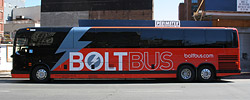I have been to a few interviews, but the most time consuming aspect of interviewing is traveling to and from the interview. I don't have a car, so I opted to take public transportation. Here, I'll just address the options as they apply to the Northeast (i.e. DC to Boston). My options have been plane, train (Amtrak), and bus (BoltBus, Megabus, Greyhound, etc.).

After having experienced both trains and buses so far, I have to admit that Amtrak is my preferred way to travel. At least up to New York, it is faster than a plane when you consider security and check-in times, as well as accessibility (Baltimore Penn Station is much closer to Hopkins than BWI Airport). Also, Amtrak ticketing is much more flexible; should plans change last minute, you can cancel any unprinted ticket and receive a full refund. Try that with a plane ticket, which is more expensive to start with.

While the BoltBus has WiFi and is cheaper than Amtrak, it is noticeably more cramped. Amtrak has wide seats and a lot of legroom, and very large overhead compartments (most suitcases that you would have to check on an airplane can even fit up there). Amtrak also has food for purchase onboard, and a tray table on which you can eat either the onboard food or food you bring on the train. Plus it is a handy place to put your laptop compared to your lap. Amtrak also has plans to put WiFi on all of its Northeast Regional trains in the future (currently it is only on Acela trains and in major stations in the Northeast Corridor).
The other main disadvantage of the BoltBus is that it takes longer than Amtrak and is subject to traffic conditions on I-95. All that said, the advantages of Amtrak seem to outweigh the higher cost of the ticket. Of course that may not be true for everyone, but I wager that for most people, $30 or so would be worth the upgrade from a bus to Amtrak.
The one case in which I could see using the plane would be for a trip up to Boston. Boston is far enough from DC/Baltimore that a train or bus affair ends up taking a good part of the day. However, if this country invests in high speed rail infrastructure, then that trip would also be competitive by train, though not any time in the near future because of how long that infrastructure would take to develop.
Anyways, that was a fairly long and rambling post. In short, don't forget about Amtrak the next time you travel in the Northeast.
Footnote: I strongly believe our country should invest in high-speed rail. If you look carefully, the opponents of such investment usually have a vested interest in the automobile, petroleum, or airline industries. As far as those that complain about the amount of money the federal government throws at Amtrak, consider that the interstate system is also largely funded by the federal government.



No comments:
Post a Comment